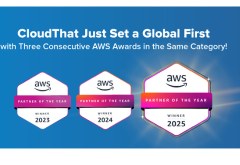With the rapid digital transformation, Indian organizations are expected to generate as much as 49 percent of the revenue from digitally connected products, services, and customer experiences by 2027, according to the IDC study commissioned by Lenovo and AMD.
The study titled ‘CIO Technology Playbook 2023,’ aims to highlight the opportunities, challenges, and considerations for CIOs in today’s data-driven economy to help them make the right IT investments. The findings indicate that CIOs are worried about how macroeconomic issues would affect corporate growth in 2023 and the first half of 2024. High energy prices are the biggest worry for CIOs in India in 2023, followed by high inflation and escalating geopolitical tensions as the other major challenge areas.
“Businesses are turning to data-driven innovation to help them make smart business decisions as digital capabilities grow. This entails keeping up with the quick advancements in Cloud, Edge, and AI/ML that must match the current infrastructure with as-a-service options. CIOs now have a more important role to play,” said Amit Luthra, Managing Director, Lenovo ISG, India. “Addressing the Asia Pacific region, the research states that enterprises in India are leading the way in exploiting cutting-edge technologies like edge innovation, with more than 97% of Indian organizations now using or planning to employ edge computing for their business operations.”
The report also shows that IT decision-makers are actively seeking ways to use technology to streamline their supply chains and boost asset utilization, agility, and resilience, allowing them to react more quickly to the shifting demands of the business. Driving improved customer experience and happiness, as well as cost optimization and savings, are the top goals for 32% of respondents, 36% of CIOs in Asia, and 36% of respondents, respectively when it comes to business priorities.
ROI to be largely driven by digital infrastructure
Businesses can increase productivity by automating jobs, streamlining processes, and using the digital infrastructure. 85% of firms in the Asia Pacific concur that digital infrastructure is necessary to accomplish business objectives. With the introduction of many clouds and quickly rising edge infrastructure, CIOs are very concerned about the complexity of IT operations and the growing need for quick responses to their constantly shifting and evolving business requirements. CIOs identified improving cyber resiliency (ranked #1 by 49% of respondents in Asia) and automating digital infrastructure management (ranked #2 by 47% of respondents in Asia) as the top investment priorities for 2023 to accelerate their digital transformation (DX) and modernize legacy IT infrastructure.
Increased Focus on Hybrid/Multi-Cloud for Cloud/Modernized Mission-Critical Workloads
Organizations have come to understand that the public cloud does not necessarily provide the greatest application experience and performance or ease the financial burden caused by rising cloud workloads. Furthermore, in the past 12 months, 63% of Asia-Pacific enterprises have been prompted to repatriate workloads from the public cloud to the private cloud and/or traditional data centers due to security concerns. It’s interesting to note that in Japan, just 40% of companies moved public workloads to private clouds. This year, the percentage of mission-critical applications operating in the public cloud in Japan will rise by less than 1 point to 19%, while it will decrease by 2% in the remaining AP markets.
In Asia, hybrid or multi-cloud is expected to become more popular during the following two to three years. More than 50% of mission-critical workloads for AP companies will still be run on traditional data center systems, platforms, and private cloud infrastructure. The highest levels of performance and compliance with data security and compliance standards are offered by hybrid or multi-cloud.
Increasing Understanding and Acceptance of Flexible As-a-Service Models
As-a-Services-based consumption models have gained a lot of ground in AP. India leads the Asia Pacific region in terms of market awareness (91%). Those that are more digitally adept, like Korea and Japan, have a significantly lower awareness level.
Organizations in AP identified cost minimization and optimization as the primary drivers of As-a-Service infrastructure to keep up with the very unstable, constantly shifting business and economic climate. Consumption-based infrastructure is flexible and agile, which enables CIOs to reduce costs and increase their spending on business innovation. In India, 90% of businesses already use or intend to use flexible IT infrastructure delivered as a service.
Unified data management leads to improved innovation
Every organization’s capacity to successfully undergo a digital transformation and, as a result, achieve digital business objectives will be hampered by data locked in cloud silos. Data must move seamlessly and securely between all of the deployment locations if data management is to be effective. Just 8% of firms use a single data management platform, despite the increasing interdependencies among applications. Currently, numerous data management platforms and technologies are used by over 78% of enterprises.
The seamless integration of data between containers and at the edge is a feature of single unified data management platforms. The foundation of the journey towards data innovation in digitally transformed enterprises will be modern single unified data management solutions for a wide variety of data kinds. CIOs that make the appropriate platform and technology investments to control the edge’s data explosion will be well-positioned to establish market leadership.
Customer experience improvement is a top focus for CIOs
Delivering a good customer experience is a growing business priority across all industries, including manufacturing, retail, logistics, transportation, and energy, to succeed in the digital economy.
AI will become widely used in 2023: CIOs in the AP area are increasingly emphasizing the use of AI to improve customer experiences. In the upcoming 12 months, more than 88% of AP firms will either be using or planning to deploy AI/ML solutions.
Businesses across various industries are expected to adopt AI-powered applications for a wide range of corporate use cases and operations. Contrarily, while having a developed digital economy, fewer businesses in Japan (74%) than elsewhere in Asia/Pacific reported utilizing or planning to employ AI applications.
The next step in the DX journey will be edge innovation: Edge is being adopted by AP quite quickly. In Asia, 88% of businesses are already employing edge computing or want to do so within the next 12 months. India holds the top spot with 97% of enterprises leveraging or utilizing cutting-edge technologies.
Edge computing enables companies to increase asset utilization, boost customer satisfaction and guarantee higher uptime or more dependability. The top use cases in AP were real-time customer insights for omnichannel experiences, automated quality control and remediation, asset tracking, geofencing, and management.
India, Japan, Korea, Indonesia, Australia, New Zealand, Singapore, Taiwan, Thailand, Hong Kong, Malaysia, and the Philippines were among the 12 major Asian markets where the study was performed.
 Latest Technology News Today – Get Latest Information Technology Updates and Services Latest Technology News Today – Get Latest Information Technology Updates and Services
Latest Technology News Today – Get Latest Information Technology Updates and Services Latest Technology News Today – Get Latest Information Technology Updates and Services 









